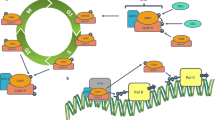Abstract
The BCR-ABL tyrosine kinase has been implicated in the dysregulation of oncogenes and tumor suppressor genes involved in chronic myelogenous leukemia (CML). Suppressor of activator protein-1, regulated by interferon (SARI), is a recently identified tumor suppressor gene whose expression has been reported to be suppressed in several malignant neoplasms. However, the expression of SARI in leukemia and the underlying regulatory mechanism remain elusive. In this study, we demonstrated that SARI mRNA expression was low in CML patients. In vitro, BCR-ABL kinase inhibitor imatinib mesylate or siRNA specific to BCR-ABL upregulated SARI mRNA expression in human leukemia cells. In addition, JAK/STAT signaling inhibitor AG490 and RAS/MAPK signaling inhibitor PD98059 upregulated SARI mRNA expression, but PI3K/AKT pathway inhibitor LY294002 had no such effect. Functionally, silencing of SARI in CML-derived cell line K562 partially decreased imatinib mesylate-induced apoptosis. Taken together, these data demonstrate that SARI mRNA expression is suppressed by BCR-ABL through the downstream signaling pathways, suggesting SARI as a potential therapeutic target in CML.




Similar content being viewed by others
References
Deininger MW, Goldman JM, Melo JV. The molecular biology of chronic myeloid leukemia. Blood. 2000;96:3343–56.
Quintas-Cardama A, Cortes J. Molecular biology of bcr-abl1-positive chronic myeloid leukemia. Blood. 2009;113:1619–30.
Hochhaus A, La Rosee P, Muller MC, Ernst T, Cross NC. Impact of BCR-ABL mutations on patients with chronic myeloid leukemia. Cell Cycle. 2011;10:250–60.
Steelman LS, Pohnert SC, Shelton JG, Franklin RA, Bertrand FE, McCubrey JA. JAK/STAT, Raf/MEK/ERK, PI3K/Akt and BCR-ABL in cell cycle progression and leukemogenesis. Leukemia. 2004;18:189–218.
Druker BJ, Talpaz M, Resta DJ, Peng B, Buchdunger E, Ford JM, et al. Efficacy and safety of a specific inhibitor of the BCR-ABL tyrosine kinase in chronic myeloid leukemia. N Engl J Med. 2001;344:1031–7.
Breccia M, Efficace F, Alimena G. Imatinib treatment in chronic myelogenous leukemia: what have we learned so far? Cancer Lett. 2011;300:115–21.
Bixby D, Talpaz M. Seeking the causes and solutions to imatinib-resistance in chronic myeloid leukemia. Leukemia. 2011;25:7–22.
Wong JC, Le Beau MM, Shannon K. Tumor suppressor gene inactivation in myeloid malignancies. Best Pract Res Clin Haematol. 2008;21:601–14.
Britschgi C, Fey MF. Tumor suppressor genes in myeloid differentiation and leukemogenesis. Future Oncol. 2009;5:245–57.
Klinakis A, Lobry C, Abdel-Wahab O, Oh P, Haeno H, Buonamici S, et al. A novel tumour-suppressor function for the Notch pathway in myeloid leukaemia. Nature. 2011;473:230–3.
Su ZZ, Lee SG, Emdad L, Lebdeva IV, Gupta P, Valerie K, et al. Cloning and characterization of SARI (suppressor of AP-1, regulated by IFN). Proc Natl Acad Sci USA. 2008;105:20906–11.
Guo L, Yu W, Li X, Zhao G, Liang J, He P, et al. Targeting of integrin-linked kinase with a small interfering RNA suppresses progression of experimental proliferative vitreoretinopathy. Exp Eye Res. 2008;87:551–60.
Huang B, Lei Z, Zhang GM, Li D, Song C, Li B, et al. SCF-mediated mast cell infiltration and activation exacerbate the inflammation and immunosuppression in tumor microenvironment. Blood. 2008;112:1269–79.
Cobaleda C, Sanchez-Garcia I. In vivo inhibition by a site-specific catalytic RNA subunit of RNase P designed against the BCR-ABL oncogenic products: a novel approach for cancer treatment. Blood. 2000;95:731–7.
Dazzi F, Szydlo RM, Goldman JM. Donor lymphocyte infusions for relapse of chronic myeloid leukemia after allogeneic stem cell transplant: where we now stand. Exp Hematol. 1999;27:1477–86.
Pinilla-Ibarz J, Cathcart K, Korontsvit T, Soignet S, Bocchia M, Caggiano J, et al. Vaccination of patients with chronic myelogenous leukemia with bcr-abl oncogene breakpoint fusion peptides generates specific immune responses. Blood. 2000;95:1781–7.
Deininger M, Buchdunger E, Druker BJ. The development of imatinib as a therapeutic agent for chronic myeloid leukemia. Blood. 2005;105:2640–53.
Schindler T, Bornmann W, Pellicena P, Miller WT, Clarkson B, Kuriyan J. Structural mechanism for STI-571 inhibition of abelson tyrosine kinase. Science. 2000;289:1938–42.
Tan TL, Yi ZS, Feng R. In vitro effect of STI571 on expression of c-kit in bone marrow cells from patients with acute non-lymphocytic leukemia. Zhongguo Shi Yan Xue Ye Xue Za Zhi. 2003;11:256–8.
Joensuu H, Dimitrijevic S. Tyrosine kinase inhibitor imatinib (STI571) as an anticancer agent for solid tumours. Ann Med. 2001;33:451–5.
Skorski T, Bellacosa A, Nieborowska-Skorska M, Majewski M, Martinez R, Choi JK, et al. Transformation of hematopoietic cells by BCR/ABL requires activation of a PI-3k/Akt-dependent pathway. EMBO J. 1997;16:6151–61.
Sillaber C, Gesbert F, Frank DA, Sattler M, Griffin JD. STAT5 activation contributes to growth and viability in Bcr/Abl-transformed cells. Blood. 2000;95:2118–25.
Deininger MW, Vieira S, Mendiola R, Schultheis B, Goldman JM, Melo JV. BCR-ABL tyrosine kinase activity regulates the expression of multiple genes implicated in the pathogenesis of chronic myeloid leukemia. Cancer Res. 2000;60:2049–55.
Angel P, Karin M. The role of Jun, Fos and the AP-1 complex in cell-proliferation and transformation. Biochim Biophys Acta. 1991;1072:129–57.
Eferl R, Wagner EF. AP-1: a double-edged sword in tumorigenesis. Nat Rev Cancer. 2003;3:859–68.
Funding
This work was supported by the National Natural Science Foundation of China (No.81100356).
Author information
Authors and Affiliations
Corresponding author
Rights and permissions
About this article
Cite this article
Huang, Q., Yang, Y., Li, X. et al. Transcription suppression of SARI (suppressor of AP-1, regulated by IFN) by BCR-ABL in human leukemia cells. Tumor Biol. 32, 1191–1197 (2011). https://doi.org/10.1007/s13277-011-0222-1
Received:
Accepted:
Published:
Issue Date:
DOI: https://doi.org/10.1007/s13277-011-0222-1




